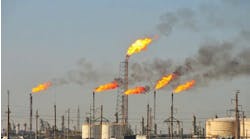"Ask the Experts" is moderated by Béla Lipták, process control consultant and editor of the Instrument Engineer's Handbook (IEH). He is currently recruiting contributors for the 5th edition. If you are qualified to contribute to this volume, or if you are qualified to answer questions in this column or want to ask a question, write to [email protected].
Q: It is well known that valves are huge energy consumers, while VFDs and pumps are less so. There has been a movement for many years to migrate from control valves to VFD-controlled pumps, but it didn't pick up steam until the notion of sustainability and reduced energy consumption became current. What are people doing to make control valves more efficient? Less pressure drop? Better actuators? Or are we seeing the last stand of the control valve?
I could really use the experts' help on this one.
Walt Boyes
[email protected]
A: To minimize energy wasted in valve friction, I usually design pump stations to have at least one variable-speed pump. If the liquid being pumped is distributed among many users, my optimization strategy is to keep opening up all user valves, until the most open valve reaches 90% opening. As shown in the interlock table in Figure 1, the second pump, which can be constant-speed also, is started up on high pressure (PSH-03), and it is turned off on low flow (FSL-05).
When I worked as an IBM consultant, I applied this strategy at a dozen IBM sites. When the buildings were low (laboratories, production plants), this strategy saved about 30%, and when used for high-rise office buildings, it saved 15% to 20%, compared to the electricity consumed prior to optimizing the building or plant.
The distribution of gas among many users (such as in HVAC applications) is optimized the same way, except that the savings are the same (~ 30%) in both high rise and low buildings. When minimizing the energy consumption of fans and/or compressors, we have to combine the valve position control (VPC) with surge protection control as shown in Figure 2.
Figure 2: Load following optimization combined with surge prevention control in gas distribution systems.
In my keynote at the next ISA conference in October, I will show similar optimization schemes for a dozen unit operations, including distillation, reactors, boilers, etc.
Bela Liptak
[email protected]
Q: I have a light oil fuel tank of 76,000 liters capacity built in 1984. The tank is horizontal and 11.5 meters long. The sensor is connected through manhole and is flanged with a diameter of 500 mm. The tank is atmospheric and we need digital level transmitter.
We measure flow by level difference. The original volumetic flowmeter was a pneumatic transmitter with a manual valve, and the measurement of the tank volume was done manually.
This system has not worked for two months, and we would like to replace it by a system that will not require any modification (welding, contracting, etc) in the existing tank. Also, we do not want to empty the tank during installation, because we do not have a spare tank and is very difficult to empty the existing one.
Mohamend A.
Esmat, Director of Engineering
[email protected]
A: A magnetostrictive level sensor, such as one from MTS (www.temposonics.com), which we developed when I was director of technology there, would work well.
Dave Nyce
[email protected]
A: I understand that you are looking for a suitable replacement with local level indication, not remote. Also you do not want to do any cutting or welding on the tank, which is understandable.
You can consider a float type of level gauge. The manhole can be removed and modified for the level gauge. This would be a simple and maintenance-free solution.
H. S. Gambhir,
Reliance Industries Ltd.
[email protected]
A: Any possibility of mounting a radar (microwave) level sensor in or around the manhole at the top of the tank? If so, that might be a reasonable solution.
Joseph Alford
[email protected]
A: You may have to make a hole in the top of the vessel, or in the manway lid.
There are several potential digital transmitter tools available.
- You can replace your existing device with a differential pressure transmitter or a bubbler if you have taps on the side and bottom of the tank.
- You can use a noncontact radar transmitter or a guided wave radar transmitter, which mounts on a 2-in. (50 mm) to 4-in. (100 mm) fitting in the top of the manway lid. You need to use radar because ultrasonic level transmitters are notoriously unreliable in atmospheric fuel oil level applications. If you are going to put it in the manway, you will have to use noncontact radar or use a flexible sensor cable for the guided wave. In this event, I would not use the guided wave systems, unless they can be installed in another tap in the tank top.
- You can use a float with an electronic sensor and transmitter or a magnetostrictive sensor. These also require making a hole in the tank. They will not be able to be installed in the manway because they are long tubes, and you will not be able to open the tank with the gauges installed.
- (My favorite) You can jack up the tank and put load cells under at least two of the support feet and go from there to an electronic transmitter. This is the method most likely to be trouble-free because you don't have to make any holes, and you can, in most cases, do an auto-calibration from whatever point the level actually is when you install the devices. There are more than a half-dozen potential vendors of these devices. They are simple and pretty much maintenance-free. The other significant appeal of the load cell approach is the likelihood that it will be less expensive (and perhaps significantly so) than any other method.
Walt Boyes
[email protected]
A: We would recommend either a magnetostrictive or guided wave radar transmitter. To give a better answer a few questions should be answered:
- Both recommended transmitters are loop-powered; is this acceptable?
- What accuracy is necessary?
The magnetostrictive is more accurate, but more problematic with viscous or dirty materials.
View specifications at our website www.magnetrol.com/select_ctry.asp) or those of other manufacturers.
Boyce Carsella
[email protected]



